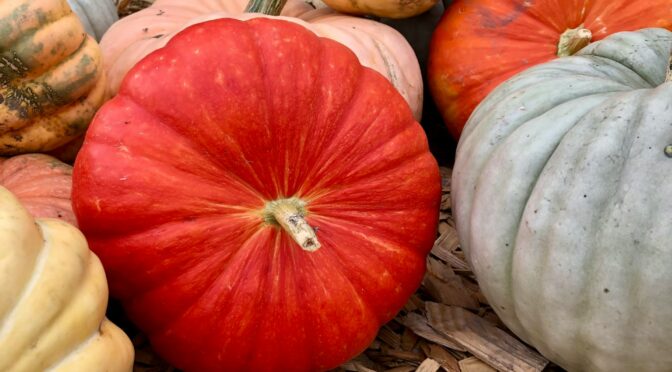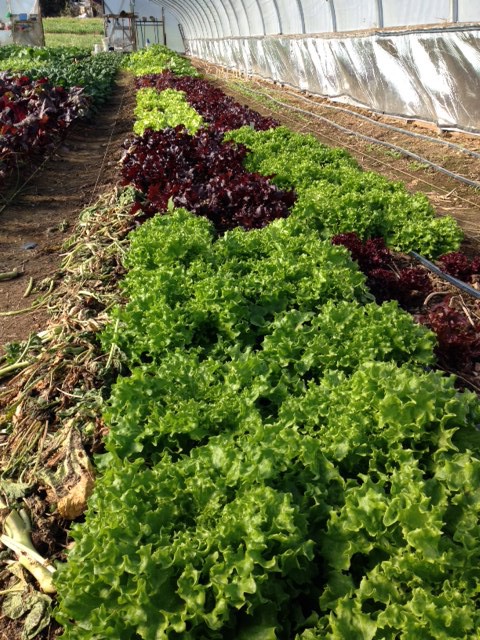From Jack O’ Lanterns and pumpkin pie to Cinderella and Camarão na moranga, pumpkins and winter squash have caught the attention of cooks, gardeners, and everyday folk worldwide. At SESE, we love the stories and flavors that come with heirloom pumpkins and winter squash. In honor of the season, we’ve decided to take a deep dive into these incredible plants including bits of history, folklore, and culinary use.
Pumpkin Versus Winter Squash
What’s the difference between pumpkin and winter squash? Are they the same species?
All winter squash and pumpkins are members of the Cucurbita genus, which is Latin for “gourd.” Depending on who you talk to, there are 13 to 30 species within this genus. The main ones we talk about are Curcurbita pepo, C. maxima, C. moschata, and C. mixta.
Pumpkins are generally what we call pumpkin-shaped winter squash, though they do come in many different shapes and sizes. While there are “pumpkins” in several of these species, people generally carve Curcurbita pepo pumpkins for Halloween.
Curcurbita pepo contains delicata winter squash, most summer squash and zucchini cultivars, and classic autumn pumpkins like the Connecticut Field Pumpkin and Small Sugar Pumpkin. These squashes tend to be more susceptible to vine borer damage, and the winter squashes and pumpkins don’t have a very long storage life. However, they sweeten up faster.
C. maxima contains many large, hard-shelled varieties that are great for storage, such as the Big Max Pumpkin, Buttercup, Rouge Vif d’Etampes (Cinderella) Pumpkin, and Candy Roaster varieties. They have delicate flesh and excellent flavor but perform best where the nights are cool and are somewhat susceptible to wilt.
C. moschata includes many long-keeping favorites, such as Magic Cushaw, Seminole Pumpkin, Old Fashioned Tenessee, and Butternut varieties. These varieties tend to have sweet, often fragrant flesh ideal for baking. They also have good resistance to vine borers and cucumber beetles but perform best in areas where nighttime temperatures remain above 60°F.
C. mixta (Also known as C. argyrosperma) tends to have coarser, less sweet flesh. They’re traditional southern crops that have fallen out of favor. Their large seeds are often ideal for roasting, and their flesh is excellent in savory dishes. We carry two varieties, Green-Striped Cushaw and Illinois (White Crookneck Pumpkin). Like moschata varieties, these have excellent resistance to vine borers and cucumber beetles. They also tolerate drought well.
The Origins of Winter Squash
So, where are these species from? By Earth’s standards, the Cucurbita genus is relatively new on the scene, dating back to the Holocene, a geological period that began roughly 11,700 years ago. Scientists believe that in the wild, they likely originated in what’s now southern Mexico, south into South America, and North into what’s now the Southwestern United States. During the Holocene, megafauna ate the fruits and distributed the seeds.
Humans were quick to see the benefits of these species, and there’s evidence that Native Americans domesticated Cucurbita species at least 8,000 years ago, with different groups growing different species from southern Canada down through western South America.
C. pepo is particularly widespread, and the domesticated cultivars like yellow crooknecks, pumpkins, and scallops are likely ancient. They were probably domesticated in several times and places. Native people have grown C. pepo in Oaxaca, Mexico, for 8,000 to 10,000 years and in the United States for at least 4,000 years.
C. maxima was less widespread. These varieties have been cultivated for at least 4,000 years in South America and were likely first domesticated in Argentina or Uruguay. Interestingly, it appears these varieties weren’t present in North America until the 16th century, although Native Americans quickly adapted them along with their C. pepo varieties.
C. moschata has been more challenging for scientists to pin down. It may have originated in many regions of Central or South America, though they know that it has been present in Mexico, Belize, Guatemala, and Peru for 4,000 to 6,000 years. Native Americans were growing one of our favorite C. moschata varieties, the Seminole Pumpkin, at the time of European contact.
C. argyrosperma is also less widespread than C. Pepo. The wild form grows from Mexico south to Nicaragua. Native Americans spread this species from the Southwestern United States south to Panama, likely focusing on them for their large seeds, which are high in protein and oil.
Over the years, folks have continued cultivating winter squash varieties and incorporating them into their own culture and cuisine worldwide. However, all of the groundwork and many of the varieties we still know and love, like Connecticut Field Pumpkins, Yellow Crookneck Summer Squash, and Seminole pumpkins, began with native farmers.

Fairytales & Traditions
It’s easy to see how these big, colorful crops tend to catch the imagination. It’s hard to imagine at the beginning of the season how much food a few plants can produce. Native Americans used them as a staple crop, often drying them in mats or spirals for winter.
They also used them as medicine. Reportedly, the Cherokee and Menominee used squash seeds as a diuretic, the Catawba chewed them for kidney issues, and the Aztecs used them to treat worms. The Mayans also used pumpkin juice as a burn salve.
European colonists and explorers quickly added pumpkins and squash to their gardens and practices. They also sent seeds back to the old world, where the large, colorful squashes were incorporated into local cuisine and medicine.
In many cultures in the Americas and abroad, pumpkins and winter squash were associated with fertility and abundance, perhaps because of their productive nature.
Though it’s impossible to pinpoint the fascination with pumpkins, it’s still present in today’s stories and legends. Especially during autumn, you may run into these crops in stories like Cinderella, The Legend of Sleep Hollow, The Marvelous Land of Oz, and The Great Pumpkin.
 Jack O’ Lanterns
Jack O’ Lanterns
So when did we start carving them, and why? The tradition begins in Ireland and Scotland with the Celtic festival of Samhain. Like Halloween, it marked the beginning of the colder months and was usually celebrated on November 1st. People believed that on Samhain, the world of the gods was visible to humans and that souls that had died in the previous year would move onto the otherworld while some would return to visit their old homes.
Samhain was also associated with the tale of Stingy Jack. He was a drunken miser that loved to play mean tricks on his family and friends. One day, he also plays a trick on the devil. When Jack eventually passed, both god and the devil turned him away. He was sentenced to roam the earth for eternity.
In Ireland, folks began carving faces into turnips to Jack’s wandering soul away. When Irish and Scottish colonists made their start in North America, they found a perfect turnip substitute, the pumpkin. Pumpkins are much easier to carve and offer a charming orange glow. It’s no wonder they’ve stuck around!

Pumpkin and Winter Squash Recipes Worldwide
In the United States, we often focus on pumpkin and winter squash for sweet, seasonal dishes like pumpkin pie, pumpkin spice lattes, and other baked goods. However, pumpkins and winter squash are wonderful in a wide variety of recipes from around the world. Consider trying a few of these with your harvest to mix things up a bit:
- Camarão na Moranga (Brazilian Shrimp Stuffed Pumpkin) from Olivia’s Cuisine
- Nhopi (Pumpkin Porridge from Zimbabwe) from Eat Well Abi
- Mexican Calabaza en tacha (Candied Pumpkin for Día de Muertos celebrations) from Mexico in My Kitchen
- Kabocha Dango with Mitarashi Glaze (Japanese Pumpkin Recipe) from Chef JA Cooks
- Olad’i iz Tykvy (Russian Pumpkin Pancakes) from Tara’s Multicultural Table
- Burmese Pumpkin Curry with Mint & Tamarind from Krumpli
- Indian Kaddu ka Halwa from Swasthi’s Recipes
- Ghapama (Armenian Stuffed Pumpkin) from The Armenian Kitchen








